Biology
Biology concepts ? pigment, carotenoids, flamingos, cyanobacteria, bacteriophage, trophic cascade effect, spirulina, alga
There are two species of flamingos in Asia and Africa, the greater and lesser flamingos. There are also four New World flamingo species, but let?s focus on the two Old World species for today ? the answer to our question holds for the New Worlders as well. Why are flamingos pink? Well, they aren?t always pink. And the reason they can be pink isn?t simple, but it?s something to which we can all relate.
In the picture to the left you see the foods of the greater and lesser flamingos. Greater flamingos have a tongue/jaw filter that excludes all but the tiny brine shrimp and those things smaller (larvae of aquatic beetles and flies), so this is what they eat. The filter assembly of the lesser flamingo is much narrower, it only lets tiny cyanobacteria (lower image) into their gullet.
When digested, the chlorophyll breaks down or is eliminated. But some other pigments, especially the carotenoids, stick around and get deposited in the tissues and feathers, now you can see them because the chlorophyll isn?t there to mask them. Why do the brine shrimp that the greater flamingos eat turn them pink? Because they feed on cyanobacteria that contain carotenoids. Their carotenoids are released when the flamingos digest the shrimp.
On the other hand, if there is little carotenoid in their diet, the feathers will be white. The pigment is lost over time, so the pigment trapped there when they were produced will fade. But flamingos molt, so that new, pink feathers replace old whitening ones. That is, if they eat their carotenoids. In zoos, their diet is often supplemented with canthaxanthin that keeps them a presentable pink. The exception ? babies always start out grey.
One last interesting point. While the lesser flamingos can live and eat in several alkaline lakes of eastern Africa, they all fly to one particular lake when it?s time to mate ? like a Club Med for pink birds. Lake Natron in Tanzania is their destination. This lake is highly alkaline, hot (nearly 130 ?F), and just chock full of minerals. The flamingos handle it just fine, but many other birds die from crashing into the highly reflective waters. The carcasses then calcify (basically, turn to stone), and wash up as little gargoyles. Even with all this deadly water, there are two species of fish that live in those waters ? I wonder if the stonefish is one of them.
Anderson MJ, & Williams SA (2010). Why do flamingos stand on one leg? Zoo biology, 29 (3), 365-74 PMID: 19637281
Peduzzi P, Gruber M, Gruber M, Schagerl M. (2014). The virus's tooth: cyanophages affect an African flamingo population in a bottom-up cascade. ISME J. , 8 (6), 1346-1351
Kotut K, Ballot A, & Krienitz L (2006). Toxic cyanobacteria and their toxins in standing waters of Kenya: implications for water resource use. Journal of water and health, 4 (2), 233-45 PMID: 16813016
- Ecology
Ecology Webquest Name: __________________________ Period: ________ Date: _____ Part I: Ecosystems and Nutrient Cycling I. FOOD CHAINS http://www.ecokids.ca/pub/eco_info/topics/frogs/chain_reaction/index.cfm and click on ?play the game? to begin. Answer...
- #101 Photosynthetic Pigments
Photosynthetic pigments are pigments presented in chloroplasts or photosynthetic bacteria. They capture light energy necessary for photosynthesis and convert it to chemical energy. PigmentsA pigment is any substance that absorbs light.The color...
- Ant Facts
If a man could run as fast for his size as an ant can, he could run as fast as a racehorse. Ants can lift 20 times their own body weight. With their combined weight greater than the combined weight of all humans, ants are the most numerous...
- Water, Water Everywhere, But?.
Biology concepts ? symbiosis, mutualism, water storage ?Gobi? means desert in Ural-Altaic,so when you say, ?Gobi Desert,? youare really being redundant.Sometimes the places with the most water are the most lifeless areas. Everyone thinks of sand and...
- The Life Of The Party
Biology concepts ? plant adaptations, osmosis, parthenogenesis Last week we discussed the biological implications of an old Christmas carol. Today?s post is a hodgepodge of holiday biology, but we can still find some exceptions. From a distance, spruce,...
Biology
Fall Leaves And Orange Flamingos
Biology concepts ? pigment, carotenoids, flamingos, cyanobacteria, bacteriophage, trophic cascade effect, spirulina, alga
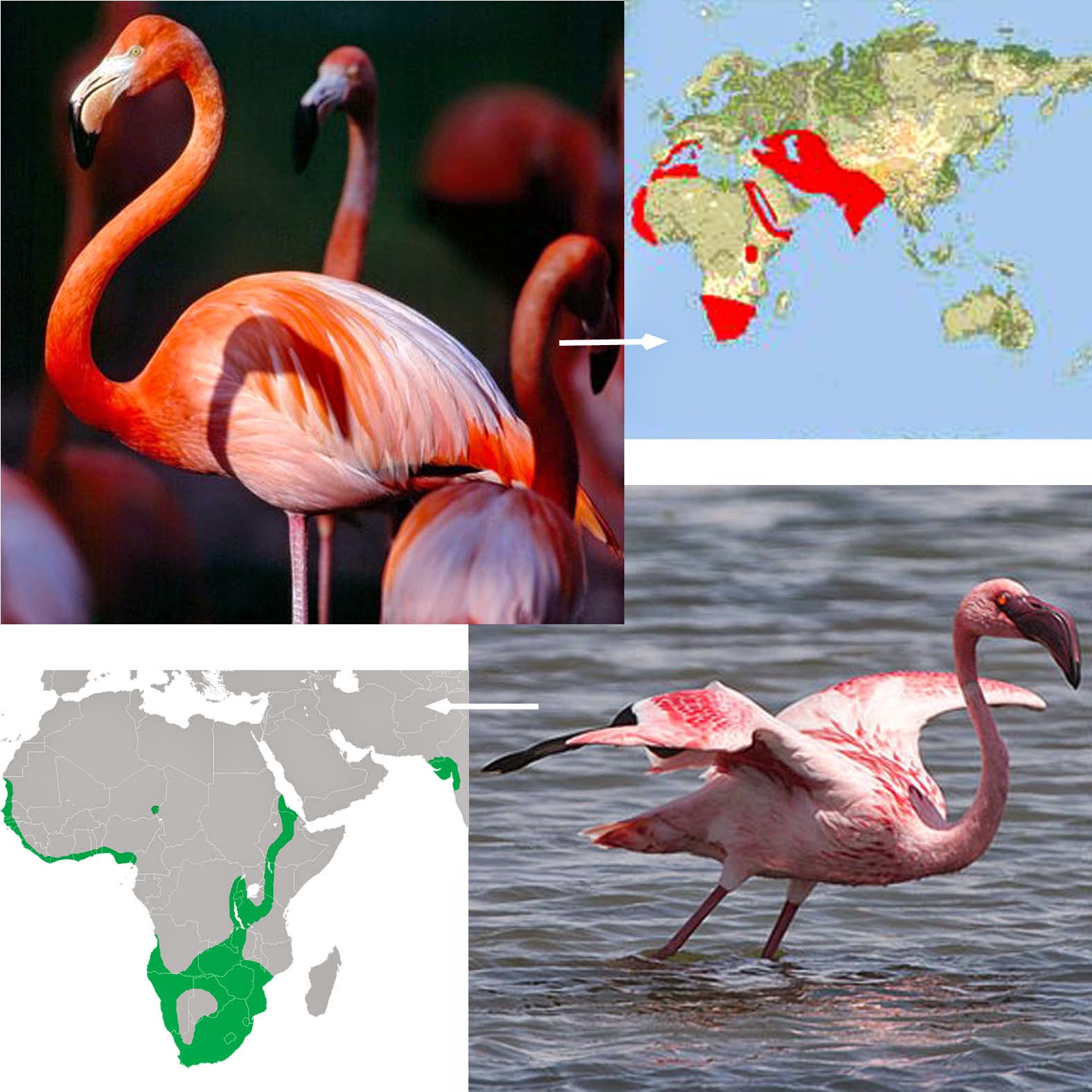 |
| These are the two species of Old World flamingos, the greater (upper left) and the lesser (bottom right). Their ranges are included, pointed out by the convenient arrows. Even though the pictures don?t show it because I couldn?t get them to stand next to one another, the greater is twice the height of the lesser, hence the names. Notice the color variation as well. However, color isn?t based on species. |
The greater flamingo(Phoenicopterus roseus) is much larger than the lesser flamingo (Phoenicopterus minor) ?- that makes sense. Greater flamingos average about 140 cm (55 in) tall, but they only weigh about 3 kg (6.6 lb). They're mostly legs, and there isn?t a lot of meat on those legs. If given a choice at the next flamingo fry, choose a breast over a drumstick.
The lesser flamingo weighs in at only 2 kg (4.4 lb) on average and are half as tall as the greater flamingo. But they make up for this in numbers. There are over 1.5-2.5 million lesser flamingos in East Africa, maybe twice as many as the greater flamingos, even though the larger species has a much broader range.
Flamingos are freaky birds. Their knees seem to bend backwards, but it's just an illusion since those backward bending joints are really their ankles. They tend to stand on one leg, and the reasons for this are not completely known. Some birds do it for camouflage, since on one leg they look more like branches. This probably doesn?t work for flamingos ? since they?re pink!
A 2010 study showed that flamingos stand on one leg much more often when they are in water, so they hypothesized that they do it to reduce the amount of body heat that is lost to the water. Also, the scientists saw that the flamingos stood on one leg in the water for less total time as the temperature increased. This was definitive proof for leg position as a method of thermoregulation.
Other theories state that flamingos might stand on one leg because it takes a lot of energy to pump blood down and then back up those long legs Birds live on the edge of starvation everyday; by pulling up one leg at a time, they can reduce the distance and therefore the energy needed for moving blood. Or, they may do it to reduce the fungal and parasite loads on each leg ? that last explanation is weak, I think.
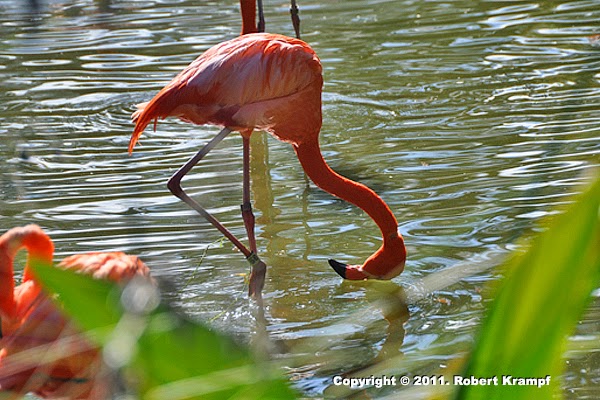 |
| All species of flamingos feed by turning their heads upside down. In this way, they can scoop in some water and filter out their food. Evolution is funny, they could have just evolved scooping lower jaws, but for some reason they have scooping upper jaws and therefore turn their heads over. Remember that evolution is a point to point exercise in mutation and possiblebenefit; it doesn?t move toward simple or toward logical. |
Flamingos also have those funky looking beaks, but they?re functional because they eat with their heads turned upside down. As a result, it?s their lower jaw that is fixed and their upper jaw swings free. They don?t use their jaw to chew their food; they don?t really have teeth.
Instead, flamingos are filter feeders. This isn?t unheard of, there are other birds that filter their food to keep only things within a certain size range and then swallow them whole, but they are the biggest of the filter feeding birds. When their two jaws come together, they form a sort of comb assembly on the sides, the wider the distance between the comb?s ?teeth,? the bigger the objects that can fit through.
Old studies shows that they use the ?teeth? (actually called lamellae) to exclude things that are too big, and then to filter out things that are too small, like excess water. The tongue sits in a deep groove and pulls in and pushes out water and those things it doesn?t eat. This pumping occurs up to 20 times per second in lesser flamingos and 6-8 times/second in greater flamingos (see this video and watch for water squirting out). Different bill shapes and different spaces and lamellae sizes are specific to each species, and each eats according to its filter.
The popular answer for why flamingos are pink is because of their diet. All that stuff we talked about above is related to that answer, but you can now sense that it?s a little more complicated. The greater and lesser flamingos have different filters because they eat different things. Yet they both end up pink.
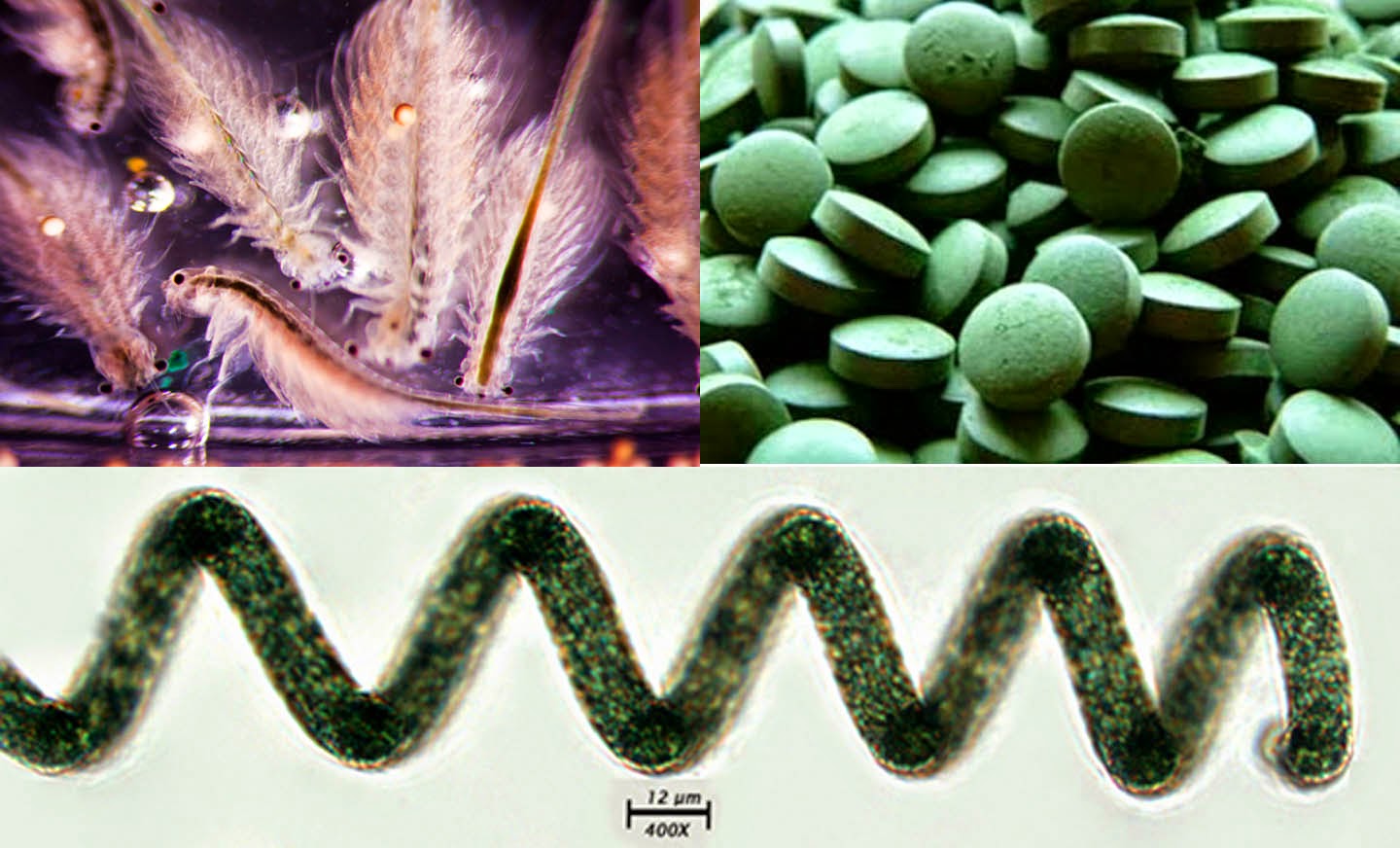 |
| Here are the major source of nutrition for the Old World flamingos. On the top left are the brine shrimp that make up the majority of the diet of greater flamingos. On the bottom is A. fusiformis, the major calorie provider for the lesser species. On the top right are spirulina tablets from a health food market, made from dried Arthospira organisms. Notice that none are pink, yet the flamingos are pink. Just how do they pick up color from their food? |
Cyanobacteria are sometimes called, perhaps incorrectly, blue-green or red algae. Alga has no clear-cut definition; some consider anything with chlorophyll and no protective cells over their gametes to be an alga, but others exclude all prokaryotes from the classification. I think the term cyanobacteria (Cyanophyta) is much more accurate.
The cyanobacteria that lesser flamingos eat used to be called Spirulina, but are now classified as species of Arthospira. A. fusiformis is the main dietary source of nutrition for lesser flamingos (of course greater flamingos eat them too; their filters let them in and keep them in), but there is also A. maximus. Together, they make up the spirulina that is popular in health food markets today.
We said above that the answer to today?s questions was that flamingos are pink or orangish based on the food they eat. But their food isn?t pink or orangish!! Look at the picture, spirulina is green. The explanation is related to something you see every year, and is something we have talked about before. It?s just like how the leaves turn colors in Autumn.
The green leaves in summer have red and other pigments, but they?re masked by so much chlorophyll (see this post). In fall, the leaves stop making chlorophyll, so the other colors shine through. The spirulina and brine shrimp have red and yellow pigments, but again there is so much green that the other colors are masked.
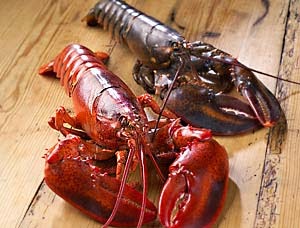 |
| Here are two lobsters. Actually, it?s one lobster and one dinner. The only difference is boiling water. The carotenoids in the shell of the live version are bound to proteins and this changes their light absorbing and reflecting properties (color). The hot water denatures the proteins and frees up the carotenoids to be the color they always dreamed of being. |
There's another reason for the different colors of food and flamingo. The pigments are sometimes complexed to proteins, and this can make them look brownish, bluish, gray, or green ? like the many species of brine shrimp, aquatic beetles, and larval flies. This is very similar to lobsters and shrimp. They're bluish or grey when scooting around in the water, but turn red/pink when they are cooked.
Carotenoids come in many varieties; their chemistries run the gamut from alcohols to esters to plain hydrocarbons. We see them in carrots (alpha and beta carotenes - orange) and tomatoes (lycopene - red) for example. Spirulina has many carotenoids, but the one there in highest concentration is called astaxanthin (pink, as in salmon meat). The percentage of different carotenoids and the total amount of them in the diet determines the color of the feathers and skin. This is why some flamingos can be bright orange, while others are very light pink.
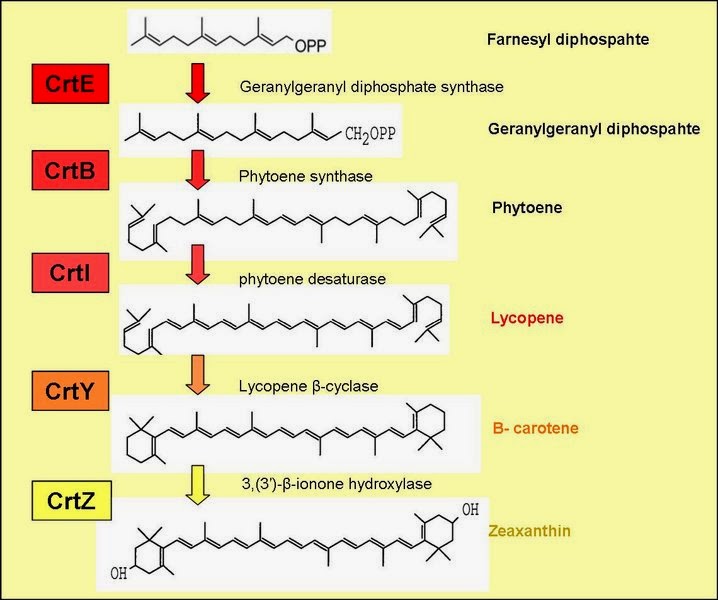 |
| These are just a few of the dozens of carotenoids found in nature. The longer the carbon chain, the lighter the color, from red to yellow. This is just a basic generality, different side chains and rings can alter the color well. And just to let you know, carotene was named for carrots, not the other way around. |
For lesser flamingos, their food is sometimes their doom. A 2006 study found that blooms of toxic cyanobacteria produce two different toxins (microcystin and anatoxin) and have been responsible for several die offs in lesser flamingo population over the last 20 years. They have also found that in some instances, the spirulina they eat will also produce toxin, but they don?t know if it is enough to kill them. Microcystin from an algae bloom is the same toxin that shut down the Toledo water system earlier this week.
What may be worse, a bacteriophage(a virus that infects bacteria, see this post) has been increasing in the alkaline lakes where the spirulina grows according to a 2014 study. It infects and kills the A. fusiformis. The kill off of the cyanobacteria leads to a trophic cascade effect; the average adult needs 70 grams of A. fusiformis a day to survive, and that is dry weight, not saturated with water. Lose the base of the food chain and everything else loses too.
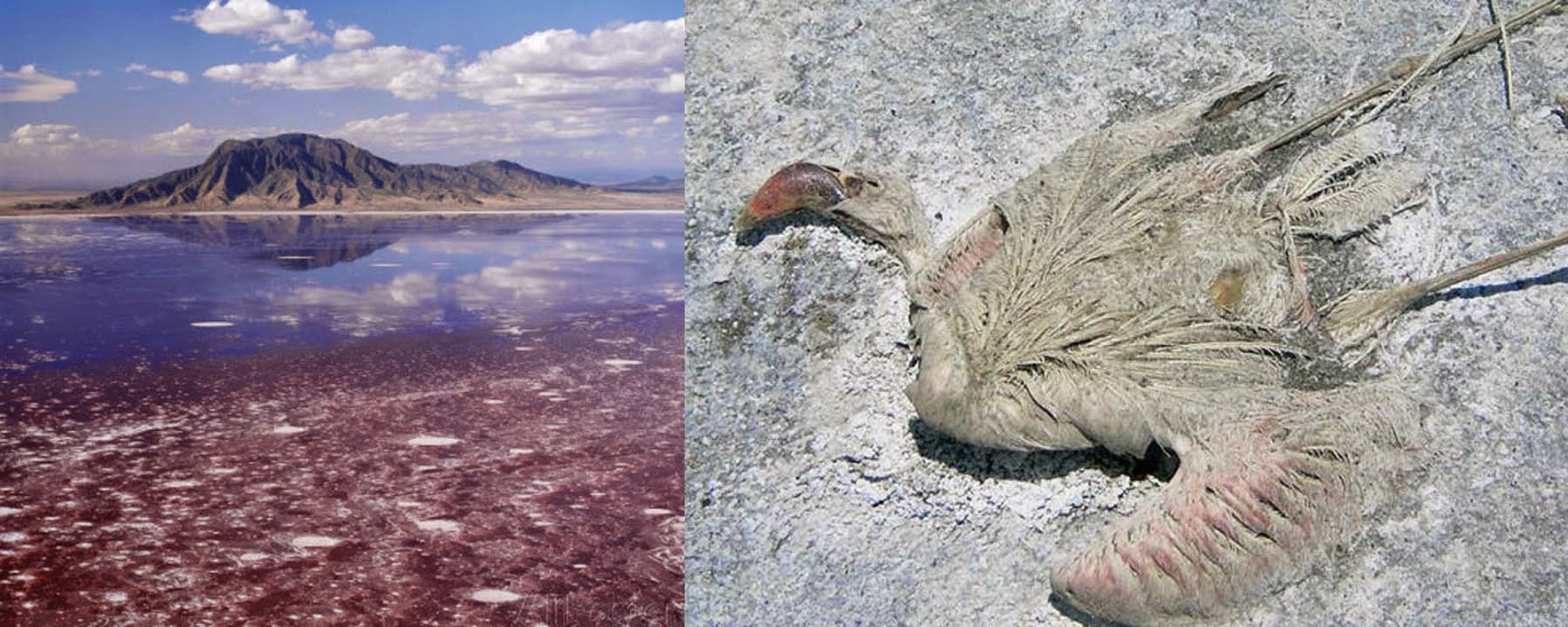 |
| Lake Natron is VERY salty, and it contains lots of other minerals. Natron is a combination of salt and minerals that the Egyptians used to mummify the bodies of those who could afford it. Not everyone got to be mummified; if that were the case, we would have many undead walking around, placing curses on successful tomb hunters. The minerals are so concentrated that dead animals that fall in end up mummified and calcified. They look like gargoyles on a French cathedral. |
Next week, another question to investigate - can living anything short of an astronaut make it to space?
- Ecology
Ecology Webquest Name: __________________________ Period: ________ Date: _____ Part I: Ecosystems and Nutrient Cycling I. FOOD CHAINS http://www.ecokids.ca/pub/eco_info/topics/frogs/chain_reaction/index.cfm and click on ?play the game? to begin. Answer...
- #101 Photosynthetic Pigments
Photosynthetic pigments are pigments presented in chloroplasts or photosynthetic bacteria. They capture light energy necessary for photosynthesis and convert it to chemical energy. PigmentsA pigment is any substance that absorbs light.The color...
- Ant Facts
If a man could run as fast for his size as an ant can, he could run as fast as a racehorse. Ants can lift 20 times their own body weight. With their combined weight greater than the combined weight of all humans, ants are the most numerous...
- Water, Water Everywhere, But?.
Biology concepts ? symbiosis, mutualism, water storage ?Gobi? means desert in Ural-Altaic,so when you say, ?Gobi Desert,? youare really being redundant.Sometimes the places with the most water are the most lifeless areas. Everyone thinks of sand and...
- The Life Of The Party
Biology concepts ? plant adaptations, osmosis, parthenogenesis Last week we discussed the biological implications of an old Christmas carol. Today?s post is a hodgepodge of holiday biology, but we can still find some exceptions. From a distance, spruce,...
